Kungälv
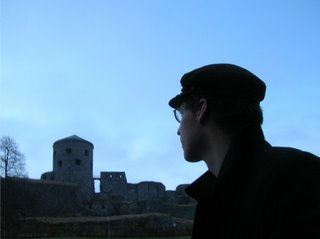 After finishing our work at Älvängen, Ole, Annette, and I loaded up in the car again and drove a bit further downriver to the castle town of Kungälv to spend the night. This was the first time I've ever been to a real castle town and I was mightliy impressed by the fortress that stood on a rocky promontory overlooking the river.
After finishing our work at Älvängen, Ole, Annette, and I loaded up in the car again and drove a bit further downriver to the castle town of Kungälv to spend the night. This was the first time I've ever been to a real castle town and I was mightliy impressed by the fortress that stood on a rocky promontory overlooking the river.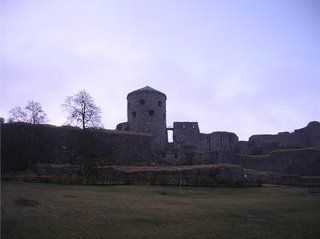 The fortress was built upon a rocky island standing in the middle of a massive fork in the Göte Älv (river/canal). Geographically, it is a very interesting spot because this fork is not the union of two tributaries but rather the splitting of the main river. From Kungälv out to the coast, the river is two separate channels flowing to two separate mouths dozens of kilometers apart.
The fortress was built upon a rocky island standing in the middle of a massive fork in the Göte Älv (river/canal). Geographically, it is a very interesting spot because this fork is not the union of two tributaries but rather the splitting of the main river. From Kungälv out to the coast, the river is two separate channels flowing to two separate mouths dozens of kilometers apart.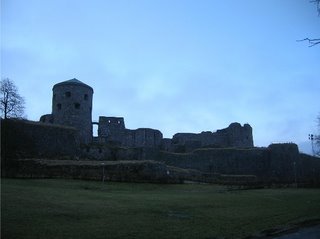 Historically, this intersection is of considerable interest as well because it was once the intersection between the Norwegian, Swedish, and Danish Kingdoms (obviously this was during a period when the Swedish military wasn't performing all that well. This place is well inside modern-day Sweden).
Historically, this intersection is of considerable interest as well because it was once the intersection between the Norwegian, Swedish, and Danish Kingdoms (obviously this was during a period when the Swedish military wasn't performing all that well. This place is well inside modern-day Sweden). Eager to venture inside, I tromped up the cobblestone path that led up to the grand gate. It was an intimidating feeling to approach this place. The walls were so massive and thick and walking up this narrow little trench there was only one escape route should an attack come from the multitude of much more advantageous positions overhead. Making an assault on this castle seems utterly out of the question...
Eager to venture inside, I tromped up the cobblestone path that led up to the grand gate. It was an intimidating feeling to approach this place. The walls were so massive and thick and walking up this narrow little trench there was only one escape route should an attack come from the multitude of much more advantageous positions overhead. Making an assault on this castle seems utterly out of the question...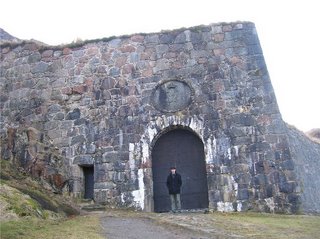
...especially when I was stopped in my tracks by the unfortuante discovery that the door was locked. Well, that ended that. Shall we raid the town instead?
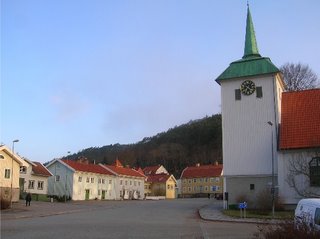 Just across the channel along the northern bank of the älv stands the little 12th century town of Kungälv, still remarkably preserved after all the centuries complete with a succession of ever-larger churches. This is the most modern one, built sometime around the American Revolution.
Just across the channel along the northern bank of the älv stands the little 12th century town of Kungälv, still remarkably preserved after all the centuries complete with a succession of ever-larger churches. This is the most modern one, built sometime around the American Revolution.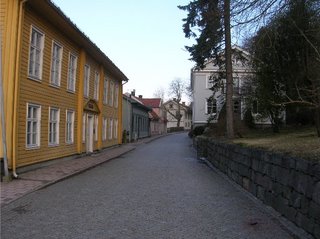 Leisurely strolling about (because this village is too charming to raid) Kungälv's little cobblestone streets, I found rows and rows of ever-so-pleasant little houses. The town is graced by the fact that it is still primarily a residence, not a tourist attraction, so the buildings retain their original dignity and are spared the intrusive, glowing Kodak and Coca-Cola sings. Indeed, to apply an over-used cliche, walking through Kungälv is a journey back in time.
Leisurely strolling about (because this village is too charming to raid) Kungälv's little cobblestone streets, I found rows and rows of ever-so-pleasant little houses. The town is graced by the fact that it is still primarily a residence, not a tourist attraction, so the buildings retain their original dignity and are spared the intrusive, glowing Kodak and Coca-Cola sings. Indeed, to apply an over-used cliche, walking through Kungälv is a journey back in time.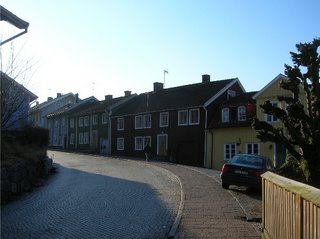 Most of the houses are still original old rowhouses with garage-style portals to let wagons into the back courtyards.
Most of the houses are still original old rowhouses with garage-style portals to let wagons into the back courtyards.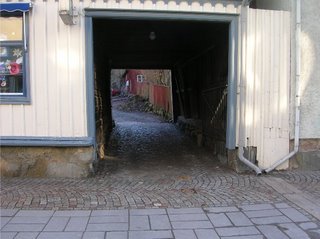 I found these portals wonderfully fun to poke my nose through to see what lay behind. Afterall, "that is where the people are living, that's where you see the real town," as Ole said to me.
I found these portals wonderfully fun to poke my nose through to see what lay behind. Afterall, "that is where the people are living, that's where you see the real town," as Ole said to me.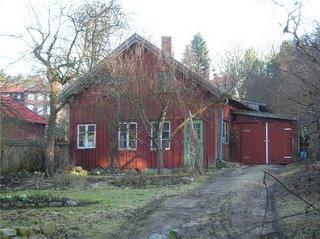 Indeed, behind the solid wooden buildings lining the streets lay wonderfully enchanting gardens and cottages.
Indeed, behind the solid wooden buildings lining the streets lay wonderfully enchanting gardens and cottages. On the morning of our second day there, I took a walk up the steeper streets leading up the hillside and along the river. Walking along, Ole and I began to formulate a theory as to why these old European villages are so much more appealing than a modern housing settlement, no matter how classical a style is used. Here, every house is unique in nearly an infinite number of little details. They are all skewed at different angles, different colors, using different dimensions of timber, and even the mouldings (often milled a century or more apart) are also of ever-so-slightly but noticeably different styles. Together, these factors give each house its own definition and singularity. It is almost impossible to develop a detailed generality for classic Swedish house design. It would defeat the purpose.
On the morning of our second day there, I took a walk up the steeper streets leading up the hillside and along the river. Walking along, Ole and I began to formulate a theory as to why these old European villages are so much more appealing than a modern housing settlement, no matter how classical a style is used. Here, every house is unique in nearly an infinite number of little details. They are all skewed at different angles, different colors, using different dimensions of timber, and even the mouldings (often milled a century or more apart) are also of ever-so-slightly but noticeably different styles. Together, these factors give each house its own definition and singularity. It is almost impossible to develop a detailed generality for classic Swedish house design. It would defeat the purpose.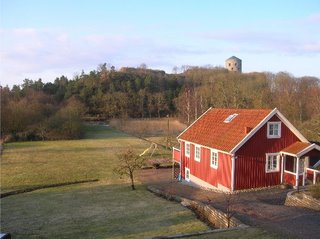 This was one was one of my absolute favorites (and not just because there was a pheasant strutting down the driveway--on the dge of the wall). I am not entirely sure just exactly what grabbed me about it; it was some fabulous combination of the morning light, the freedom of having escaped the city, the sweeping lawn down to the river, and then there was that awesome castle watching over it all. It was glorious....
This was one was one of my absolute favorites (and not just because there was a pheasant strutting down the driveway--on the dge of the wall). I am not entirely sure just exactly what grabbed me about it; it was some fabulous combination of the morning light, the freedom of having escaped the city, the sweeping lawn down to the river, and then there was that awesome castle watching over it all. It was glorious....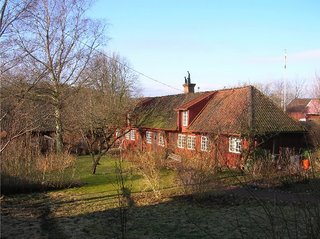 Then there was this little place which was also definitely one of my favorites. This typically-Nordic looking workshop tucked in a nest of budding bushes and vines almost seemed to beg for an artist to come and set up an eisel.
Then there was this little place which was also definitely one of my favorites. This typically-Nordic looking workshop tucked in a nest of budding bushes and vines almost seemed to beg for an artist to come and set up an eisel. A little further along, at the edge of town, I found a pasture full of cattle out grazing in the morning sun. With the river beyond, the spectacle reminded me very much of those morning bike rides I used to go for outside Beloit, Wisconsin. No wonder so many Swedes moved to the Midwest, it looked, smelled, and felt like home.
A little further along, at the edge of town, I found a pasture full of cattle out grazing in the morning sun. With the river beyond, the spectacle reminded me very much of those morning bike rides I used to go for outside Beloit, Wisconsin. No wonder so many Swedes moved to the Midwest, it looked, smelled, and felt like home.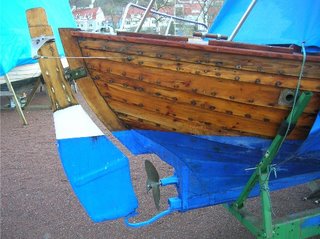 Wandering back down to the river I eventually found the boatyard (as I always do). It was mostly plastic Tupperware boats, but there were a few classic wooden hulls being readied for the season.
Wandering back down to the river I eventually found the boatyard (as I always do). It was mostly plastic Tupperware boats, but there were a few classic wooden hulls being readied for the season.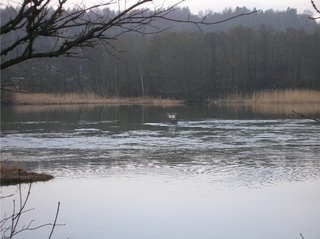
I also discovered Kungälv's sense of humor. This concrete pilon standing in the middle of one of the forks in the river--probably the remains of a bygone bridge--had caught someone's eye with its profile and the wake it left in the swiftly flowing river and inspired that someone to go out there and paint "U-137" on its side. Indeed, at first glance it certainly looked like a U-boat working its way into the Swedish heartland.
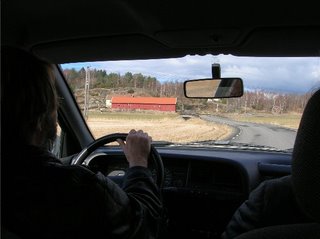
Then, after an exquisite breakfast buffet in the hotel restaurant, we hit the road again--onward to the coast and open water! Good Lord, I needed it!

0 Comments:
Post a Comment
<< Home